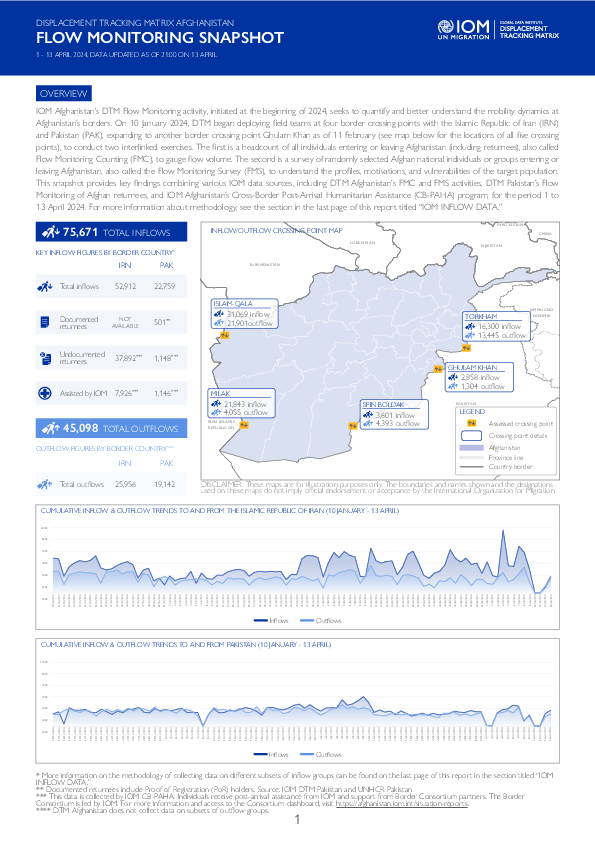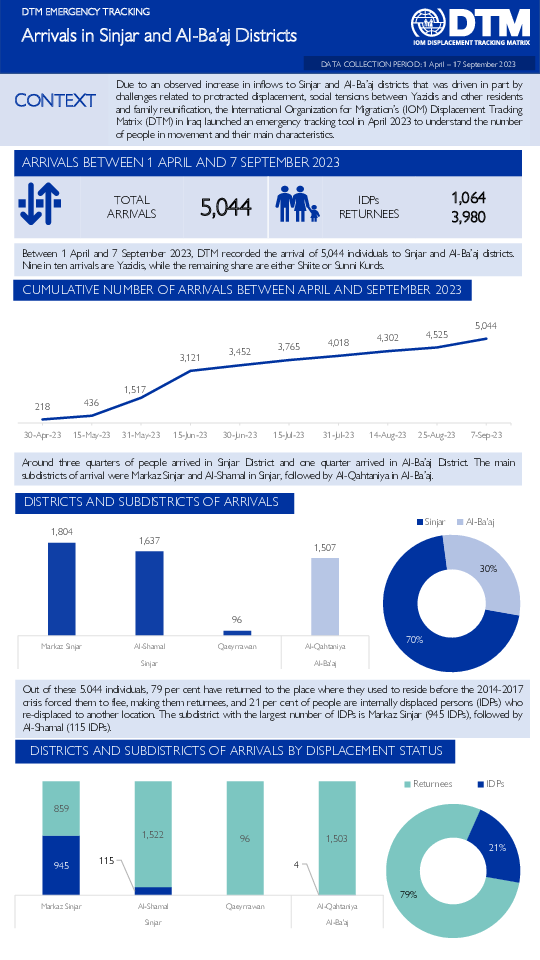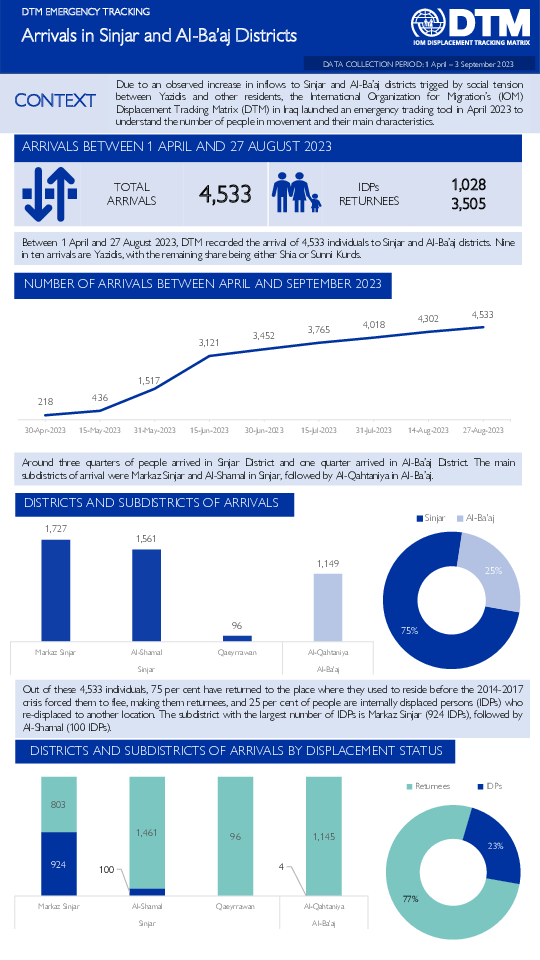-
Countries
-
Data and Analysis
-
Special Focus
-
Crisis Responses

Contact
IraqDTM@iom.int
Language
English
Location
Iraq
Period Covered
Sep 01 2022
Nov 30 2022
Activity
- Survey
- Flow Monitoring
DTM Iraq collects data at border crossing points with neighboring countries – the Islamic Republic of Iran (Iran), the Syrian Arab Republic (Syria) and the Republic of Türkiye (Türkiye) – to better understand migration movements in the Middle East. Cross-border monitoring data were collected employing two approaches: a headcount of all travellers entering or leaving Iraq and a survey of randomly selected travellers. Data collection took place between 1 September and 30 November 2022. Further details on the survey methodology, selection of respondents and border crossing points are available in the Methodological Overview on the DTM website.
Following previous period, DTM team continuing its efforts of collecting data on issues that may signify protection risks and concerns among travellers passing through the monitored border crossing points for reasons relating to labour. This report presents a count of those travelling for work, as well as their main socio-demographic characteristics, type of employment/job offer pursued and possible indicators of exploitation such as performing work or any activities against their will, without getting the expected payment, receiving false information about the nature or the location of the work.

Contact
IraqDTM@iom.int
Language
English
Location
Iraq
Period Covered
Dec 01 2022
Feb 28 2023
Activity
- Survey
- Flow Monitoring
DTM Iraq collects data at border crossing points with neighboring countries – the Islamic Republic of Iran (Iran), the Syrian Arab Republic (Syria) and the Republic of Türkiye (Türkiye) – to better understand migration movements in the Middle East. Cross-border monitoring data were collected employing two approaches: a headcount of all travellers entering or leaving Iraq and a survey of randomly selected travellers. Data collection took place between 1 December 2022 and 28 February 2023. Further details on the survey methodology, selection of respondents and border crossing points are available in the Methodological Overview on the DTM website.
As part of this activity, the DTM team continued its efforts to collect data on issues that may signify protection risks and concerns among travellers passing through the monitored border crossing points for labour-related reasons. This report presents a count of those travelling for work, as well as their main socio-demographic characteristics, type of employment/job offer pursued and possible indicators of exploitation such as performing work or any activities against their will, without getting the expected payment or receiving false information about the nature or the location of the work.

Contact
IraqDTM@iom.int
Language
English
Location
Iraq
Period Covered
Apr 01 2023
Nov 01 2023
Activity
- Mobility Tracking
- Event Tracking
Due to an observed increase in inflows to Sinjar and Al-Ba’aj districts driven in part by challenges related to protracted displacement, social tensions between Yazidis and other residents and family reunification, the International Organization for Migration’s (IOM) Displacement Tracking Matrix (DTM) in Iraq launched an emergency tracking tool in April 2023 to understand the number of people in movement and their main characteristics. After seven months of data collection and tracking this will be the last update due to the significant decrease in the number of arrivals.

Contact
IraqDTM@iom.int
Language
English
Location
Iraq
Period Covered
Apr 01 2023
Oct 15 2024
Activity
- Mobility Tracking
- Event Tracking
Due to an observed increase in inflows to Sinjar and Al-Ba’aj districts that was driven in part by challenges related to protracted displacement, social tensions between Yazidis and other residents and family reunification, the International Organization for Migration’s (IOM) Displacement Tracking Matrix (DTM) in Iraq launched an emergency tracking tool in April 2023 to understand the number of people in movement and their main characteristics.

Contact
IraqDTM@iom.int
Language
English
Location
Iraq
Period Covered
Apr 01 2023
Oct 01 2023
Activity
- Mobility Tracking
- Event Tracking
Due to an observed increase in inflows to Sinjar and Al-Ba’aj districts that was driven in part by challenges related to protracted displacement, social tensions between Yazidis and other residents and family reunification, the International Organization for Migration’s (IOM) Displacement Tracking Matrix (DTM) in Iraq launched an emergency tracking tool in April 2023 to understand the number of people in movement and their main characteristics.

Contact
DTMAfghanistan@iom.int
Language
English
Location
Afghanistan
Period Covered
Apr 01 2024
Apr 13 2024
Activity
- Survey
- Flow Monitoring Survey
- Flow Monitoring
IOM Afghanistan's DTM Flow Monitoring activity, initiated at the beginning of 2024, seeks to quantify and better understand the mobility dynamics at Afghanistan’s borders. On 10 January 2024, DTM began deploying field teams at four border crossing points with the Islamic Republic of Iran (IRN) and Pakistan (PAK), expanding to another border crossing point Ghulam Khan as of 11 February (see map below for the locations of all five crossing points), to conduct two interlinked exercises. The first is a headcount of all individuals entering or leaving Afghanistan (including returnees), also called Flow Monitoring Counting (FMC), to gauge flow volume. The second is a survey of randomly selected Afghan national individuals or groups entering or leaving Afghanistan, also called the Flow Monitoring Survey (FMS), to understand the profiles, motivations, and vulnerabilities of the target population. This snapshot provides key findings combining various IOM data sources, including DTM Afghanistan’s FMC and FMS activities, DTM Pakistan’s Flow Monitoring of Afghan returnees, and IOM Afghanistan’s Cross-Border Post-Arrival Humanitarian Assistance (CB-PAHA) program, for the period 1 to 13 April 2024. For more information about methodology, see the section in the last page of this report titled “IOM INFLOW DATA.”

Contact
IraqDTM@iom.int
Language
English
Location
Iraq
Period Covered
Apr 01 2023
Sep 17 2023
Activity
- Mobility Tracking
- Event Tracking
Due to an observed increase in inflows to Sinjar and Al-Ba’aj districts that was driven in part by challenges related to protracted displacement, social tensions between Yazidis and other residents and family reunification, the International Organization for Migration’s (IOM) Displacement Tracking Matrix (DTM) in Iraq launched an emergency tracking tool in April 2023 to understand the number of people in movement and their main characteristics.

Contact
IraqDTM@iom.int
Language
English
Location
Iraq
Period Covered
Apr 01 2023
Sep 03 2023
Activity
- Mobility Tracking
- Event Tracking
Due to an observed increase in inflows to Sinjar and Al-Ba’aj districts trigged by social tension between Yazidis and other residents, the International Organization for Migration’s (IOM) Displacement Tracking Matrix (DTM) in Iraq launched an emergency tracking tool in April 2023 to understand the number of people in movement and their main characteristics.

Contact
IraqDTM@iom.int
Language
English
Location
Iraq
Period Covered
Apr 01 2023
Aug 20 2023
Activity
- Mobility Tracking
- Event Tracking
Due to an observed increase in inflows to Sinjar and Al-Ba’aj districts trigged by social tension between Yazidis and other residents, the International Organization for Migration’s (IOM) Displacement Tracking Matrix (DTM) in Iraq launched an emergency tracking tool in April 2023 to understand the number of people in movement and their main characteristics.
Contact
dtmuganda@iom.int vwabwire@iom.in
Location
Uganda
Activity
- Mobility Tracking
- Event Tracking
- Baseline Assessment
Period Covered
Mar 10 2024 -Mar 29 2024
In March, the impacts of the hazards affected 10,390 individuals (2,387 households), with 426 people from 91 households were internally displaced. Children below the age of 18 were the most affected age group (67%), followed by adults (18-64) at 30% and elderly above 64 (3%). Notably, more than half of affected people were female (62%).
A more detailed version of this dataset, including the number of the vulnerabilities, is available. To get access, kindly click on the 'Request Access' button.
Population Groups
IDPs
Residents
Survey Methodology
Unit of Analysis Or Observation
Admin Area 2
Admin Area 3
Community
Type of Survey or Assessment
Key Informant
Keywords
Geographical Scope Partial Coverage
Administrative boundaries with available data
The current dataset covers the following administrative boundaries